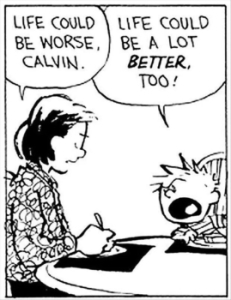
The most important thing in communication is hearing what isn’t said. – Peter Drucker
A worker asked for a pay raise and got this note back from his supervisor: “Because of the fluctuation predisposition of your position’s productive capacity as juxtaposed to standard norms, it would be momentarily injudicious to advocate your requested increment.” The puzzled worker went to the supervisor and said, “Is this is about my pay raise I don’t get?” “That’s right,” said the supervisor.
As a leader one of the most important skills you will develop is communication. Unfortunately, it’s becoming one of the hardest skills to develop. The reasons for this vary. On the bright side, technology has increased our ability to communicate like never before. On the down side, conversational and social skills have waned because we prefer to text or send an email- thus avoiding actual human interaction.
Communicating with clarity is important for you as a leader. Those you lead don’t need to be like the man in the story above trying to figure out what you are saying. Here are a few simple guidelines to keep in mind going forward.
Keep it simple
Avoid as much as possible all the fancy corporate jargon. Keep it simple. Your goal here is not to impress people with your vocabulary but to inspire your team with your words and actions.
Keep it pithy
Don’t waste your people’s time with never ending meetings and chasing proverbial rabbits. The longer things drag out the more your people tune out. Have an objective, stick to it, and get going.
Be transparent
Nothing will endear your people to you more than to by being open and honest about where you are personally, where things are as an organization, and by reminding your people of the vision and the role they play in fulfilling it.
Be inclusive
Clarity is essential throughout your organization. As the leader you need to make sure everyone knows your heart and that you have their backs, and that they have all the knowledge and information they need to be successful.
Know when to speak, and speak on purpose
When communicating with your people it is important that you have a reason and purpose behind it. What you say and how you say it is important. What a team members “hears” and interprets may be very different from said and meant. Before you speak, think it through and put yourself in their shoes.
Know when to shut up
I’ve saved the most important for last. Clarity comes to us best not when we are speaking but when we are listening. The most powerful communication skill you have is your silence and your open mind. It is when you listen to your people that you have your greatest moments of clarity. Someone once said, “God gave you two ears and one mouth for a reason.” That’s great advice.
Communicating with clarity is essential to your success as a leader. Use these guidelines as starting points and build upon them. Your success as a leader depends upon it.
What tips would you add?
© 2016 Doug Dickerson







